Evaluating Vodafone's HR Strategies for Workforce Improvement
VerifiedAdded on 2023/01/13
|10
|2452
|31
Report
AI Summary
This report provides an in-depth analysis of Vodafone's Human Resource (HR) strategies, focusing on how the company aims to improve its workforce performance, foster a positive organizational culture, and enhance employee engagement. The report begins with an executive summary and a table of contents, followed by an introduction to Vodafone as a multinational telecommunications company. It then delves into three key areas: performance-related initiatives, such as performance-based rewards and compensation systems; culture-related initiatives, including diversity and inclusion programs; and engagement-related initiatives, such as flexible benefit schemes and communication strategies. The report also offers recommendations for improving these HR strategies, including suggestions for performance appraisal, managing a multicultural workplace, and enhancing employee relations. The analysis draws on various academic sources and concludes with a summary of the findings.
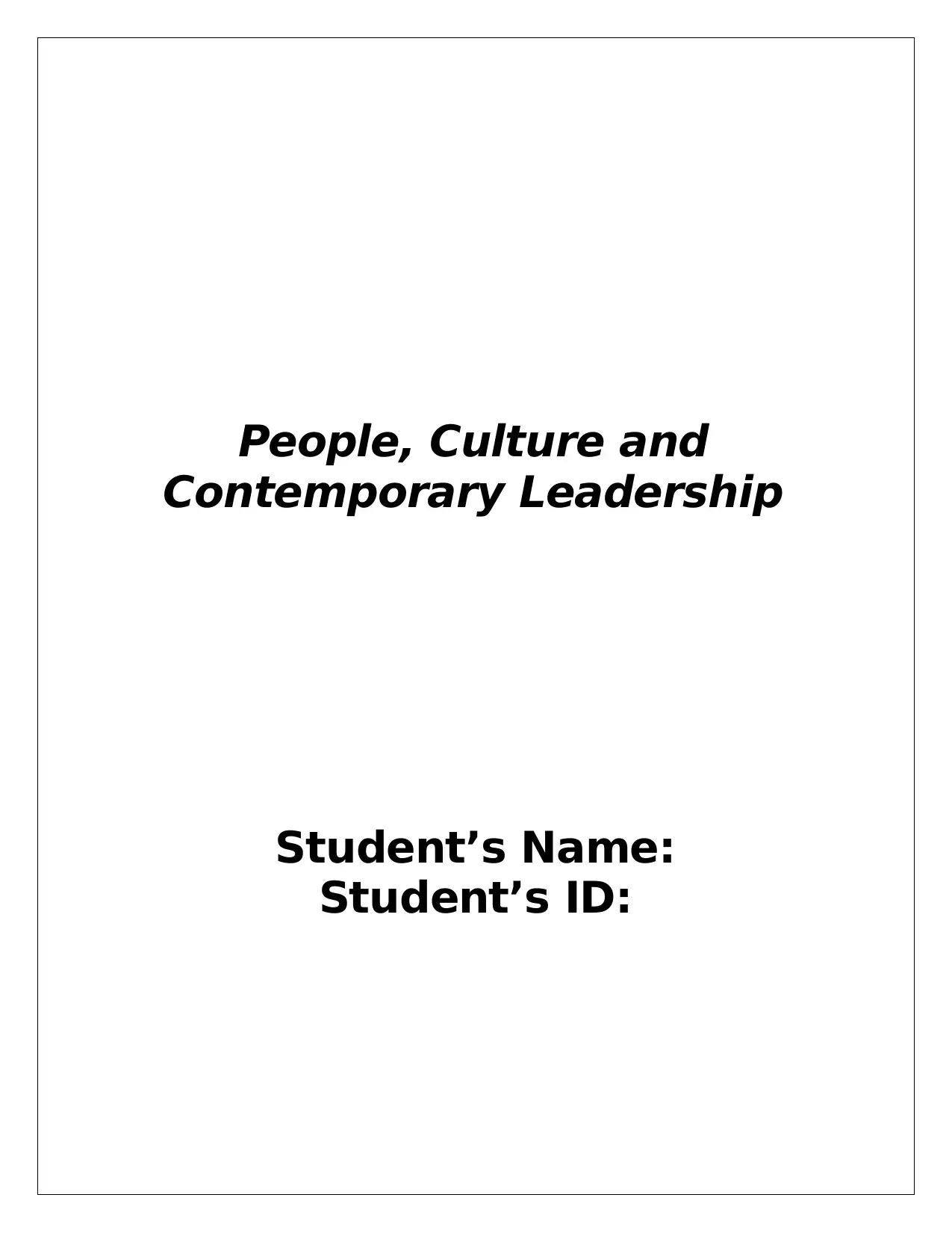
People, Culture and
Contemporary Leadership
Student’s Name:
Student’s ID:
Contemporary Leadership
Student’s Name:
Student’s ID:
Paraphrase This Document
Need a fresh take? Get an instant paraphrase of this document with our AI Paraphraser
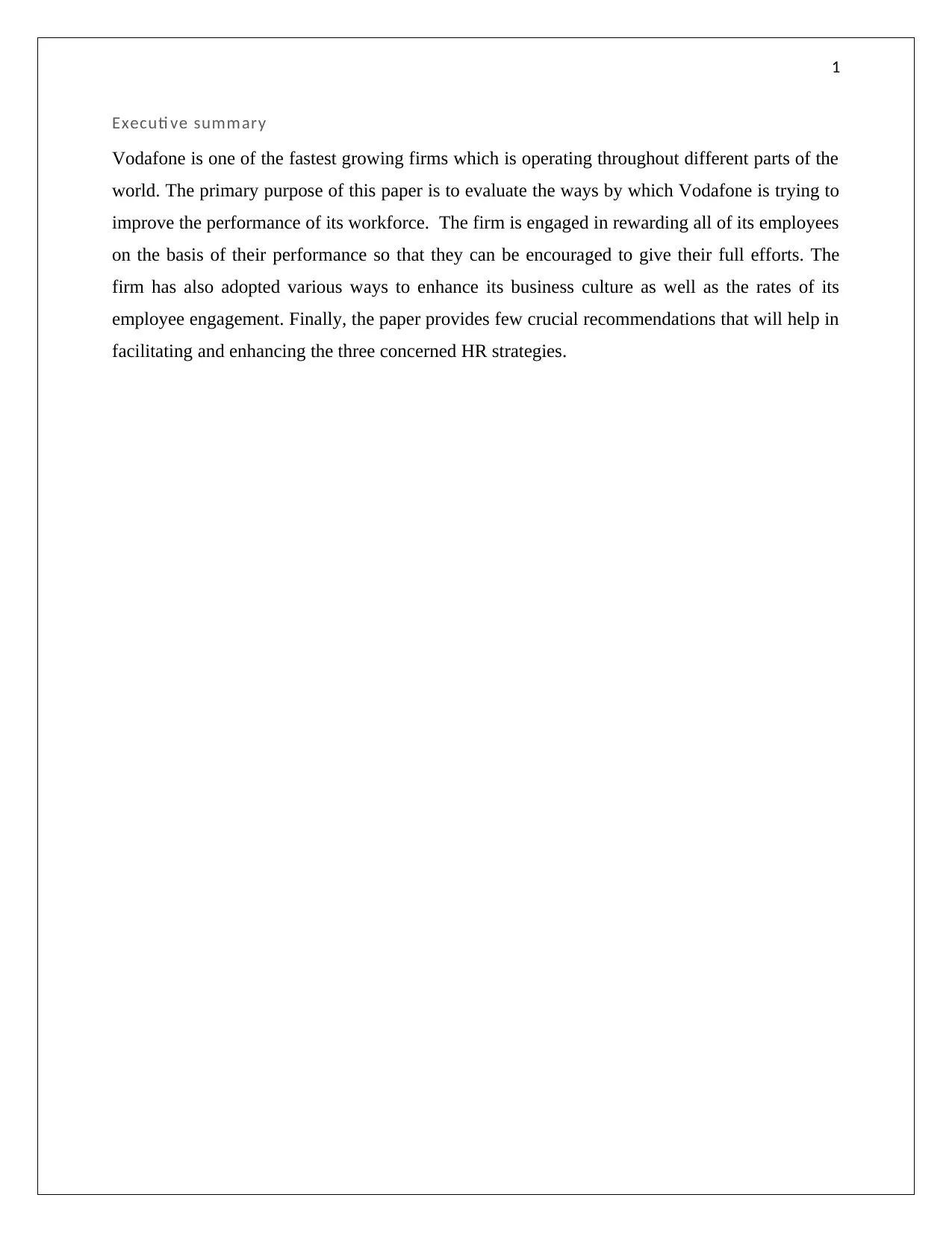
1
Executi ve summary
Vodafone is one of the fastest growing firms which is operating throughout different parts of the
world. The primary purpose of this paper is to evaluate the ways by which Vodafone is trying to
improve the performance of its workforce. The firm is engaged in rewarding all of its employees
on the basis of their performance so that they can be encouraged to give their full efforts. The
firm has also adopted various ways to enhance its business culture as well as the rates of its
employee engagement. Finally, the paper provides few crucial recommendations that will help in
facilitating and enhancing the three concerned HR strategies.
Executi ve summary
Vodafone is one of the fastest growing firms which is operating throughout different parts of the
world. The primary purpose of this paper is to evaluate the ways by which Vodafone is trying to
improve the performance of its workforce. The firm is engaged in rewarding all of its employees
on the basis of their performance so that they can be encouraged to give their full efforts. The
firm has also adopted various ways to enhance its business culture as well as the rates of its
employee engagement. Finally, the paper provides few crucial recommendations that will help in
facilitating and enhancing the three concerned HR strategies.
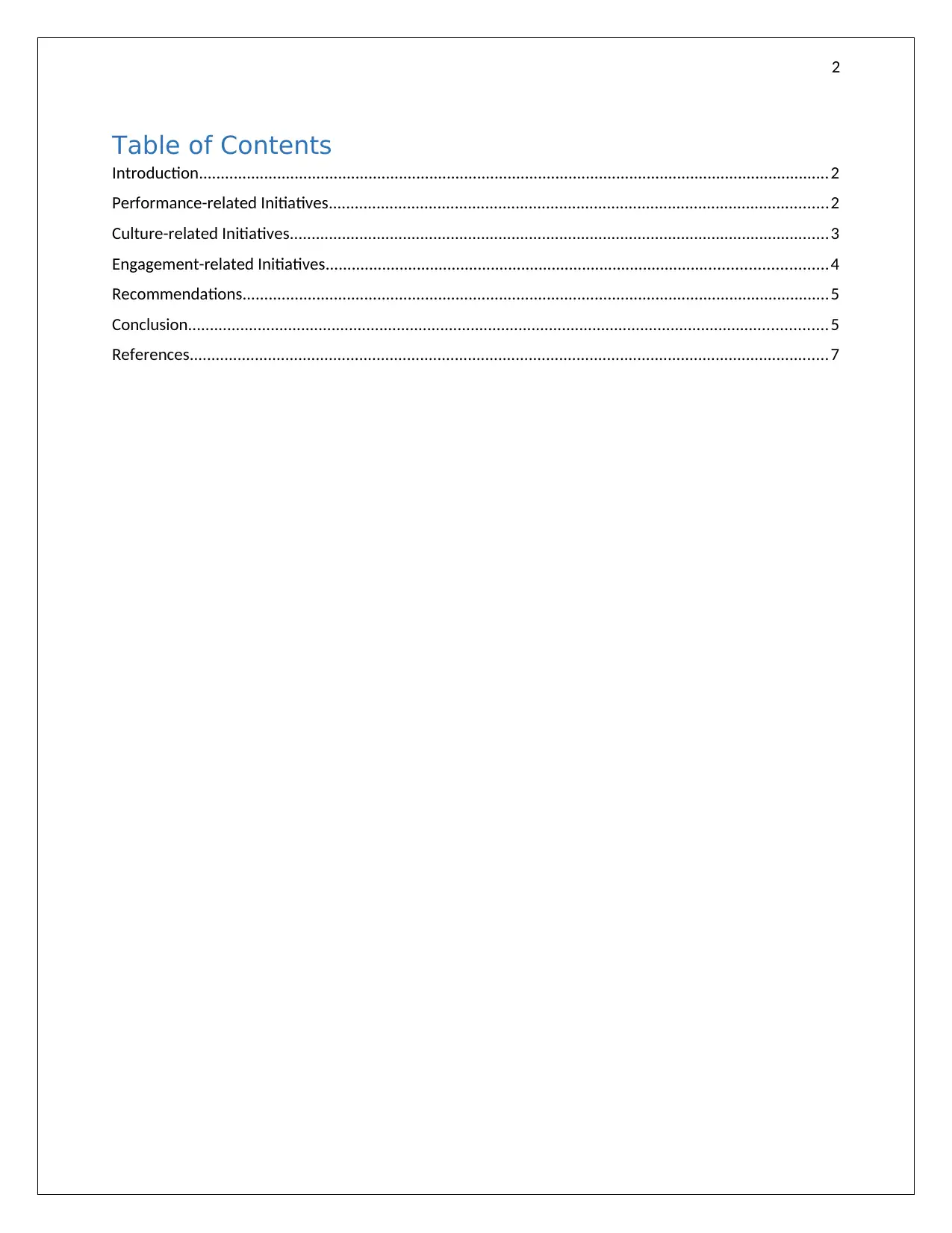
2
Table of Contents
Introduction.................................................................................................................................................2
Performance-related Initiatives...................................................................................................................2
Culture-related Initiatives............................................................................................................................3
Engagement-related Initiatives...................................................................................................................4
Recommendations.......................................................................................................................................5
Conclusion...................................................................................................................................................5
References...................................................................................................................................................7
Table of Contents
Introduction.................................................................................................................................................2
Performance-related Initiatives...................................................................................................................2
Culture-related Initiatives............................................................................................................................3
Engagement-related Initiatives...................................................................................................................4
Recommendations.......................................................................................................................................5
Conclusion...................................................................................................................................................5
References...................................................................................................................................................7
⊘ This is a preview!⊘
Do you want full access?
Subscribe today to unlock all pages.

Trusted by 1+ million students worldwide
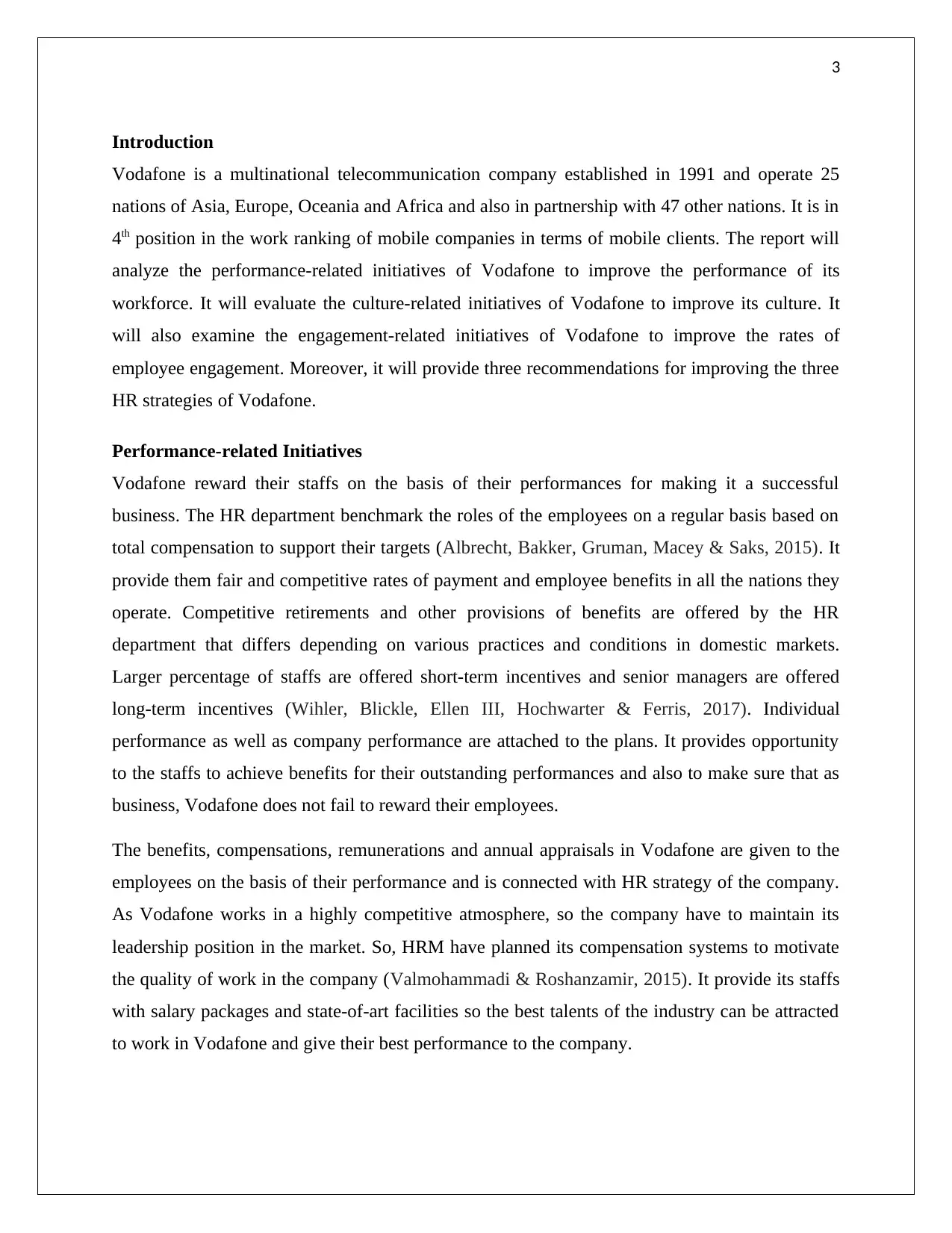
3
Introduction
Vodafone is a multinational telecommunication company established in 1991 and operate 25
nations of Asia, Europe, Oceania and Africa and also in partnership with 47 other nations. It is in
4th position in the work ranking of mobile companies in terms of mobile clients. The report will
analyze the performance-related initiatives of Vodafone to improve the performance of its
workforce. It will evaluate the culture-related initiatives of Vodafone to improve its culture. It
will also examine the engagement-related initiatives of Vodafone to improve the rates of
employee engagement. Moreover, it will provide three recommendations for improving the three
HR strategies of Vodafone.
Performance-related Initiatives
Vodafone reward their staffs on the basis of their performances for making it a successful
business. The HR department benchmark the roles of the employees on a regular basis based on
total compensation to support their targets (Albrecht, Bakker, Gruman, Macey & Saks, 2015). It
provide them fair and competitive rates of payment and employee benefits in all the nations they
operate. Competitive retirements and other provisions of benefits are offered by the HR
department that differs depending on various practices and conditions in domestic markets.
Larger percentage of staffs are offered short-term incentives and senior managers are offered
long-term incentives (Wihler, Blickle, Ellen III, Hochwarter & Ferris, 2017). Individual
performance as well as company performance are attached to the plans. It provides opportunity
to the staffs to achieve benefits for their outstanding performances and also to make sure that as
business, Vodafone does not fail to reward their employees.
The benefits, compensations, remunerations and annual appraisals in Vodafone are given to the
employees on the basis of their performance and is connected with HR strategy of the company.
As Vodafone works in a highly competitive atmosphere, so the company have to maintain its
leadership position in the market. So, HRM have planned its compensation systems to motivate
the quality of work in the company (Valmohammadi & Roshanzamir, 2015). It provide its staffs
with salary packages and state-of-art facilities so the best talents of the industry can be attracted
to work in Vodafone and give their best performance to the company.
Introduction
Vodafone is a multinational telecommunication company established in 1991 and operate 25
nations of Asia, Europe, Oceania and Africa and also in partnership with 47 other nations. It is in
4th position in the work ranking of mobile companies in terms of mobile clients. The report will
analyze the performance-related initiatives of Vodafone to improve the performance of its
workforce. It will evaluate the culture-related initiatives of Vodafone to improve its culture. It
will also examine the engagement-related initiatives of Vodafone to improve the rates of
employee engagement. Moreover, it will provide three recommendations for improving the three
HR strategies of Vodafone.
Performance-related Initiatives
Vodafone reward their staffs on the basis of their performances for making it a successful
business. The HR department benchmark the roles of the employees on a regular basis based on
total compensation to support their targets (Albrecht, Bakker, Gruman, Macey & Saks, 2015). It
provide them fair and competitive rates of payment and employee benefits in all the nations they
operate. Competitive retirements and other provisions of benefits are offered by the HR
department that differs depending on various practices and conditions in domestic markets.
Larger percentage of staffs are offered short-term incentives and senior managers are offered
long-term incentives (Wihler, Blickle, Ellen III, Hochwarter & Ferris, 2017). Individual
performance as well as company performance are attached to the plans. It provides opportunity
to the staffs to achieve benefits for their outstanding performances and also to make sure that as
business, Vodafone does not fail to reward their employees.
The benefits, compensations, remunerations and annual appraisals in Vodafone are given to the
employees on the basis of their performance and is connected with HR strategy of the company.
As Vodafone works in a highly competitive atmosphere, so the company have to maintain its
leadership position in the market. So, HRM have planned its compensation systems to motivate
the quality of work in the company (Valmohammadi & Roshanzamir, 2015). It provide its staffs
with salary packages and state-of-art facilities so the best talents of the industry can be attracted
to work in Vodafone and give their best performance to the company.
Paraphrase This Document
Need a fresh take? Get an instant paraphrase of this document with our AI Paraphraser
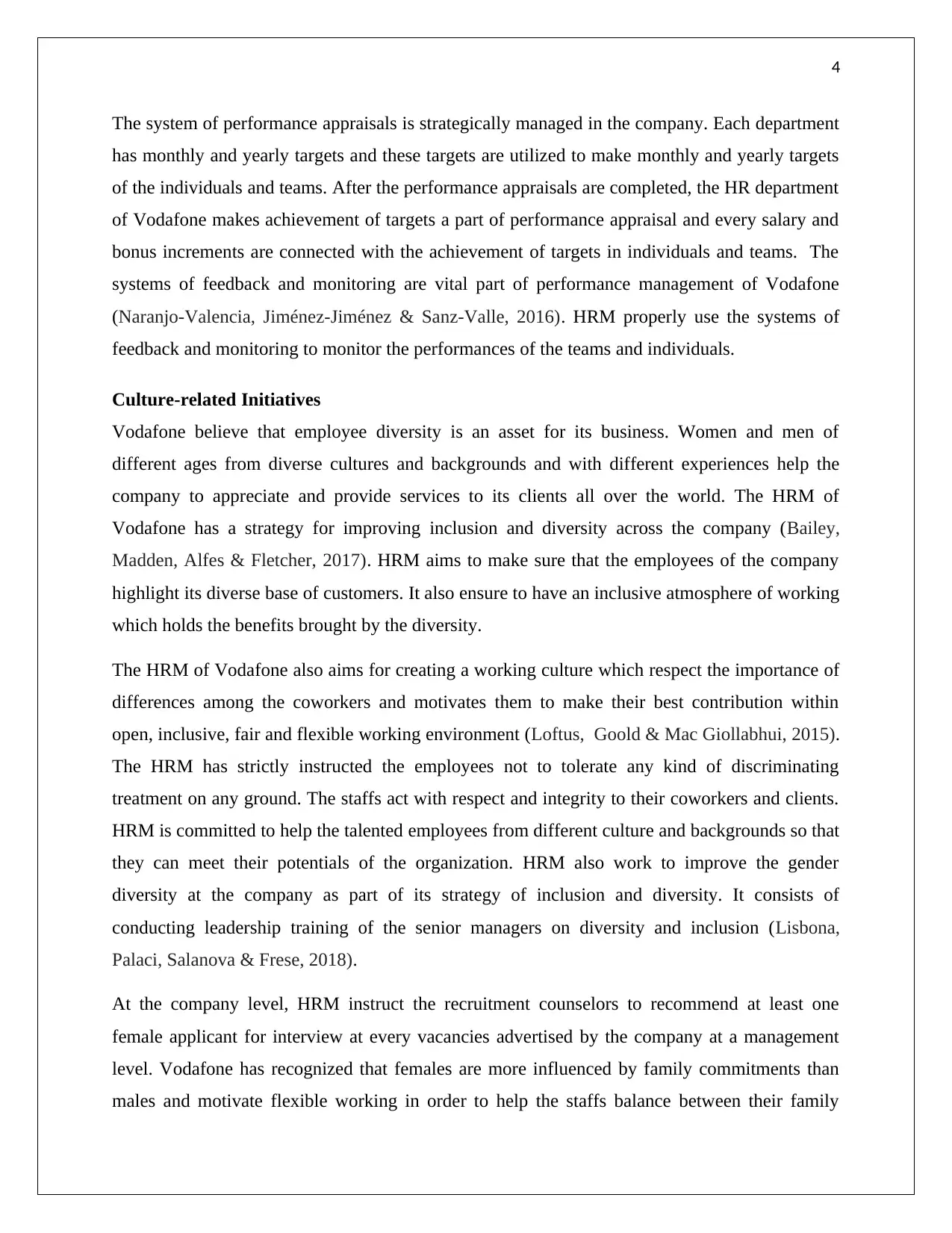
4
The system of performance appraisals is strategically managed in the company. Each department
has monthly and yearly targets and these targets are utilized to make monthly and yearly targets
of the individuals and teams. After the performance appraisals are completed, the HR department
of Vodafone makes achievement of targets a part of performance appraisal and every salary and
bonus increments are connected with the achievement of targets in individuals and teams. The
systems of feedback and monitoring are vital part of performance management of Vodafone
(Naranjo-Valencia, Jiménez-Jiménez & Sanz-Valle, 2016). HRM properly use the systems of
feedback and monitoring to monitor the performances of the teams and individuals.
Culture-related Initiatives
Vodafone believe that employee diversity is an asset for its business. Women and men of
different ages from diverse cultures and backgrounds and with different experiences help the
company to appreciate and provide services to its clients all over the world. The HRM of
Vodafone has a strategy for improving inclusion and diversity across the company (Bailey,
Madden, Alfes & Fletcher, 2017). HRM aims to make sure that the employees of the company
highlight its diverse base of customers. It also ensure to have an inclusive atmosphere of working
which holds the benefits brought by the diversity.
The HRM of Vodafone also aims for creating a working culture which respect the importance of
differences among the coworkers and motivates them to make their best contribution within
open, inclusive, fair and flexible working environment (Loftus, Goold & Mac Giollabhui, 2015).
The HRM has strictly instructed the employees not to tolerate any kind of discriminating
treatment on any ground. The staffs act with respect and integrity to their coworkers and clients.
HRM is committed to help the talented employees from different culture and backgrounds so that
they can meet their potentials of the organization. HRM also work to improve the gender
diversity at the company as part of its strategy of inclusion and diversity. It consists of
conducting leadership training of the senior managers on diversity and inclusion (Lisbona,
Palaci, Salanova & Frese, 2018).
At the company level, HRM instruct the recruitment counselors to recommend at least one
female applicant for interview at every vacancies advertised by the company at a management
level. Vodafone has recognized that females are more influenced by family commitments than
males and motivate flexible working in order to help the staffs balance between their family
The system of performance appraisals is strategically managed in the company. Each department
has monthly and yearly targets and these targets are utilized to make monthly and yearly targets
of the individuals and teams. After the performance appraisals are completed, the HR department
of Vodafone makes achievement of targets a part of performance appraisal and every salary and
bonus increments are connected with the achievement of targets in individuals and teams. The
systems of feedback and monitoring are vital part of performance management of Vodafone
(Naranjo-Valencia, Jiménez-Jiménez & Sanz-Valle, 2016). HRM properly use the systems of
feedback and monitoring to monitor the performances of the teams and individuals.
Culture-related Initiatives
Vodafone believe that employee diversity is an asset for its business. Women and men of
different ages from diverse cultures and backgrounds and with different experiences help the
company to appreciate and provide services to its clients all over the world. The HRM of
Vodafone has a strategy for improving inclusion and diversity across the company (Bailey,
Madden, Alfes & Fletcher, 2017). HRM aims to make sure that the employees of the company
highlight its diverse base of customers. It also ensure to have an inclusive atmosphere of working
which holds the benefits brought by the diversity.
The HRM of Vodafone also aims for creating a working culture which respect the importance of
differences among the coworkers and motivates them to make their best contribution within
open, inclusive, fair and flexible working environment (Loftus, Goold & Mac Giollabhui, 2015).
The HRM has strictly instructed the employees not to tolerate any kind of discriminating
treatment on any ground. The staffs act with respect and integrity to their coworkers and clients.
HRM is committed to help the talented employees from different culture and backgrounds so that
they can meet their potentials of the organization. HRM also work to improve the gender
diversity at the company as part of its strategy of inclusion and diversity. It consists of
conducting leadership training of the senior managers on diversity and inclusion (Lisbona,
Palaci, Salanova & Frese, 2018).
At the company level, HRM instruct the recruitment counselors to recommend at least one
female applicant for interview at every vacancies advertised by the company at a management
level. Vodafone has recognized that females are more influenced by family commitments than
males and motivate flexible working in order to help the staffs balance between their family
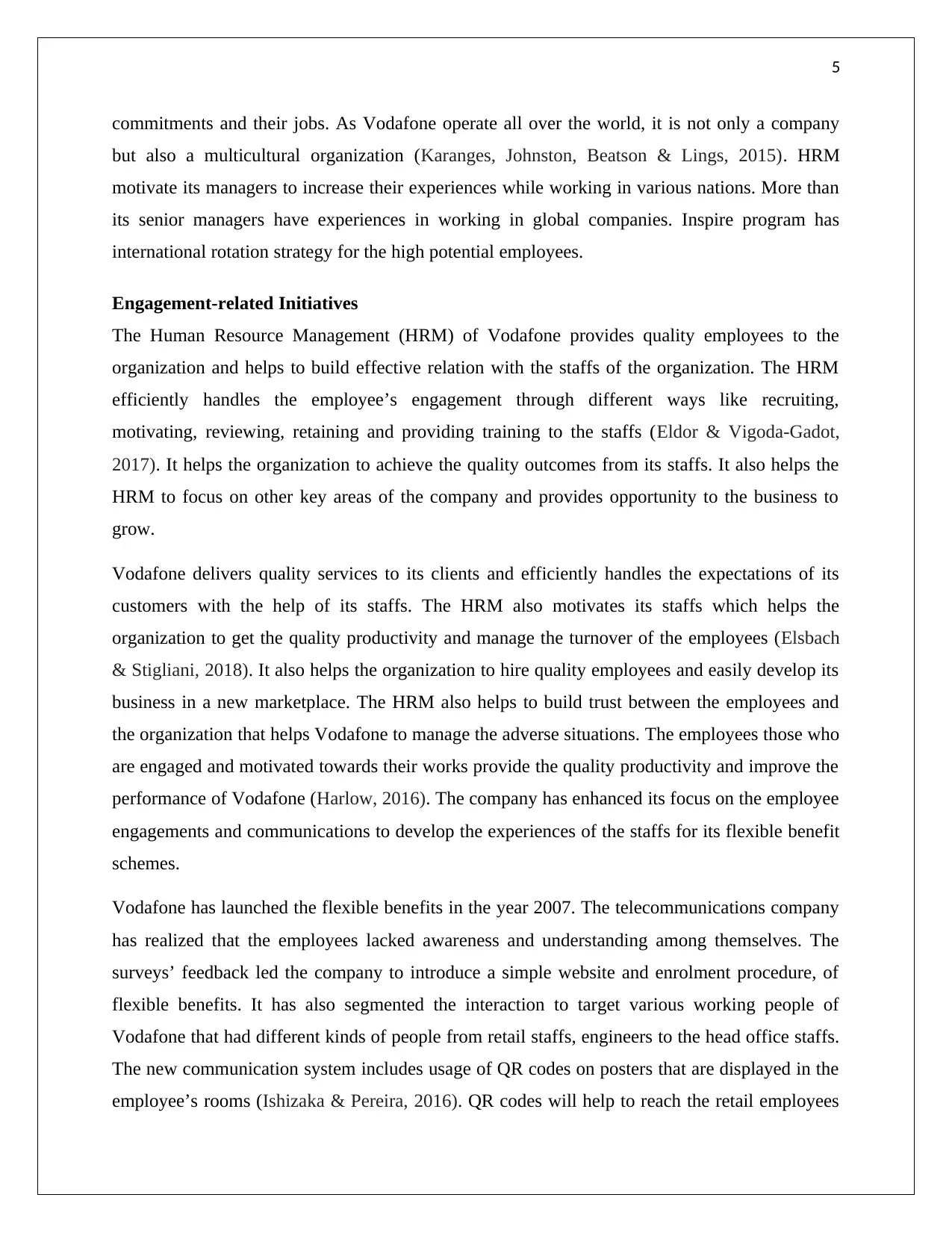
5
commitments and their jobs. As Vodafone operate all over the world, it is not only a company
but also a multicultural organization (Karanges, Johnston, Beatson & Lings, 2015). HRM
motivate its managers to increase their experiences while working in various nations. More than
its senior managers have experiences in working in global companies. Inspire program has
international rotation strategy for the high potential employees.
Engagement-related Initiatives
The Human Resource Management (HRM) of Vodafone provides quality employees to the
organization and helps to build effective relation with the staffs of the organization. The HRM
efficiently handles the employee’s engagement through different ways like recruiting,
motivating, reviewing, retaining and providing training to the staffs (Eldor & Vigoda-Gadot,
2017). It helps the organization to achieve the quality outcomes from its staffs. It also helps the
HRM to focus on other key areas of the company and provides opportunity to the business to
grow.
Vodafone delivers quality services to its clients and efficiently handles the expectations of its
customers with the help of its staffs. The HRM also motivates its staffs which helps the
organization to get the quality productivity and manage the turnover of the employees (Elsbach
& Stigliani, 2018). It also helps the organization to hire quality employees and easily develop its
business in a new marketplace. The HRM also helps to build trust between the employees and
the organization that helps Vodafone to manage the adverse situations. The employees those who
are engaged and motivated towards their works provide the quality productivity and improve the
performance of Vodafone (Harlow, 2016). The company has enhanced its focus on the employee
engagements and communications to develop the experiences of the staffs for its flexible benefit
schemes.
Vodafone has launched the flexible benefits in the year 2007. The telecommunications company
has realized that the employees lacked awareness and understanding among themselves. The
surveys’ feedback led the company to introduce a simple website and enrolment procedure, of
flexible benefits. It has also segmented the interaction to target various working people of
Vodafone that had different kinds of people from retail staffs, engineers to the head office staffs.
The new communication system includes usage of QR codes on posters that are displayed in the
employee’s rooms (Ishizaka & Pereira, 2016). QR codes will help to reach the retail employees
commitments and their jobs. As Vodafone operate all over the world, it is not only a company
but also a multicultural organization (Karanges, Johnston, Beatson & Lings, 2015). HRM
motivate its managers to increase their experiences while working in various nations. More than
its senior managers have experiences in working in global companies. Inspire program has
international rotation strategy for the high potential employees.
Engagement-related Initiatives
The Human Resource Management (HRM) of Vodafone provides quality employees to the
organization and helps to build effective relation with the staffs of the organization. The HRM
efficiently handles the employee’s engagement through different ways like recruiting,
motivating, reviewing, retaining and providing training to the staffs (Eldor & Vigoda-Gadot,
2017). It helps the organization to achieve the quality outcomes from its staffs. It also helps the
HRM to focus on other key areas of the company and provides opportunity to the business to
grow.
Vodafone delivers quality services to its clients and efficiently handles the expectations of its
customers with the help of its staffs. The HRM also motivates its staffs which helps the
organization to get the quality productivity and manage the turnover of the employees (Elsbach
& Stigliani, 2018). It also helps the organization to hire quality employees and easily develop its
business in a new marketplace. The HRM also helps to build trust between the employees and
the organization that helps Vodafone to manage the adverse situations. The employees those who
are engaged and motivated towards their works provide the quality productivity and improve the
performance of Vodafone (Harlow, 2016). The company has enhanced its focus on the employee
engagements and communications to develop the experiences of the staffs for its flexible benefit
schemes.
Vodafone has launched the flexible benefits in the year 2007. The telecommunications company
has realized that the employees lacked awareness and understanding among themselves. The
surveys’ feedback led the company to introduce a simple website and enrolment procedure, of
flexible benefits. It has also segmented the interaction to target various working people of
Vodafone that had different kinds of people from retail staffs, engineers to the head office staffs.
The new communication system includes usage of QR codes on posters that are displayed in the
employee’s rooms (Ishizaka & Pereira, 2016). QR codes will help to reach the retail employees
⊘ This is a preview!⊘
Do you want full access?
Subscribe today to unlock all pages.

Trusted by 1+ million students worldwide
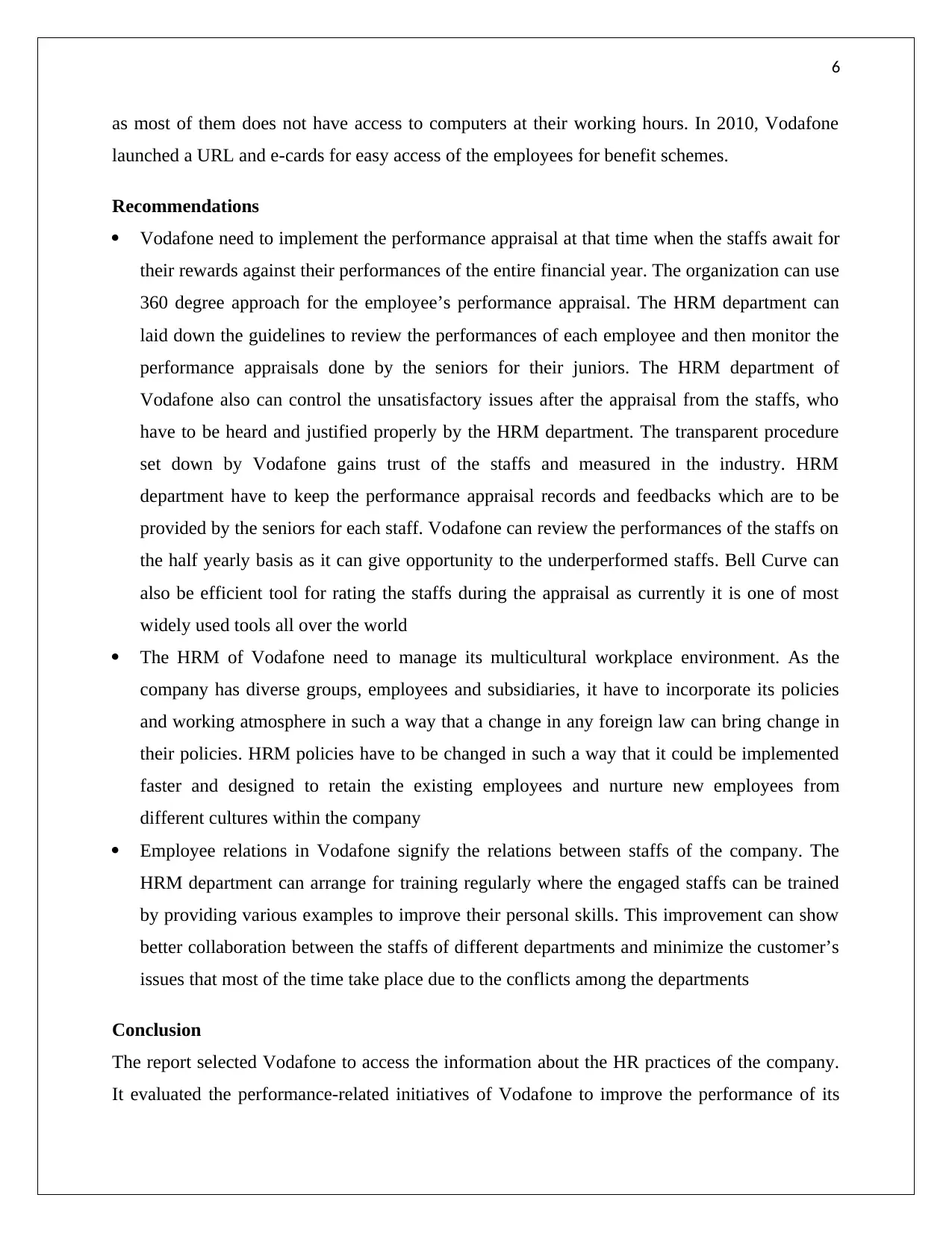
6
as most of them does not have access to computers at their working hours. In 2010, Vodafone
launched a URL and e-cards for easy access of the employees for benefit schemes.
Recommendations
Vodafone need to implement the performance appraisal at that time when the staffs await for
their rewards against their performances of the entire financial year. The organization can use
360 degree approach for the employee’s performance appraisal. The HRM department can
laid down the guidelines to review the performances of each employee and then monitor the
performance appraisals done by the seniors for their juniors. The HRM department of
Vodafone also can control the unsatisfactory issues after the appraisal from the staffs, who
have to be heard and justified properly by the HRM department. The transparent procedure
set down by Vodafone gains trust of the staffs and measured in the industry. HRM
department have to keep the performance appraisal records and feedbacks which are to be
provided by the seniors for each staff. Vodafone can review the performances of the staffs on
the half yearly basis as it can give opportunity to the underperformed staffs. Bell Curve can
also be efficient tool for rating the staffs during the appraisal as currently it is one of most
widely used tools all over the world
The HRM of Vodafone need to manage its multicultural workplace environment. As the
company has diverse groups, employees and subsidiaries, it have to incorporate its policies
and working atmosphere in such a way that a change in any foreign law can bring change in
their policies. HRM policies have to be changed in such a way that it could be implemented
faster and designed to retain the existing employees and nurture new employees from
different cultures within the company
Employee relations in Vodafone signify the relations between staffs of the company. The
HRM department can arrange for training regularly where the engaged staffs can be trained
by providing various examples to improve their personal skills. This improvement can show
better collaboration between the staffs of different departments and minimize the customer’s
issues that most of the time take place due to the conflicts among the departments
Conclusion
The report selected Vodafone to access the information about the HR practices of the company.
It evaluated the performance-related initiatives of Vodafone to improve the performance of its
as most of them does not have access to computers at their working hours. In 2010, Vodafone
launched a URL and e-cards for easy access of the employees for benefit schemes.
Recommendations
Vodafone need to implement the performance appraisal at that time when the staffs await for
their rewards against their performances of the entire financial year. The organization can use
360 degree approach for the employee’s performance appraisal. The HRM department can
laid down the guidelines to review the performances of each employee and then monitor the
performance appraisals done by the seniors for their juniors. The HRM department of
Vodafone also can control the unsatisfactory issues after the appraisal from the staffs, who
have to be heard and justified properly by the HRM department. The transparent procedure
set down by Vodafone gains trust of the staffs and measured in the industry. HRM
department have to keep the performance appraisal records and feedbacks which are to be
provided by the seniors for each staff. Vodafone can review the performances of the staffs on
the half yearly basis as it can give opportunity to the underperformed staffs. Bell Curve can
also be efficient tool for rating the staffs during the appraisal as currently it is one of most
widely used tools all over the world
The HRM of Vodafone need to manage its multicultural workplace environment. As the
company has diverse groups, employees and subsidiaries, it have to incorporate its policies
and working atmosphere in such a way that a change in any foreign law can bring change in
their policies. HRM policies have to be changed in such a way that it could be implemented
faster and designed to retain the existing employees and nurture new employees from
different cultures within the company
Employee relations in Vodafone signify the relations between staffs of the company. The
HRM department can arrange for training regularly where the engaged staffs can be trained
by providing various examples to improve their personal skills. This improvement can show
better collaboration between the staffs of different departments and minimize the customer’s
issues that most of the time take place due to the conflicts among the departments
Conclusion
The report selected Vodafone to access the information about the HR practices of the company.
It evaluated the performance-related initiatives of Vodafone to improve the performance of its
Paraphrase This Document
Need a fresh take? Get an instant paraphrase of this document with our AI Paraphraser
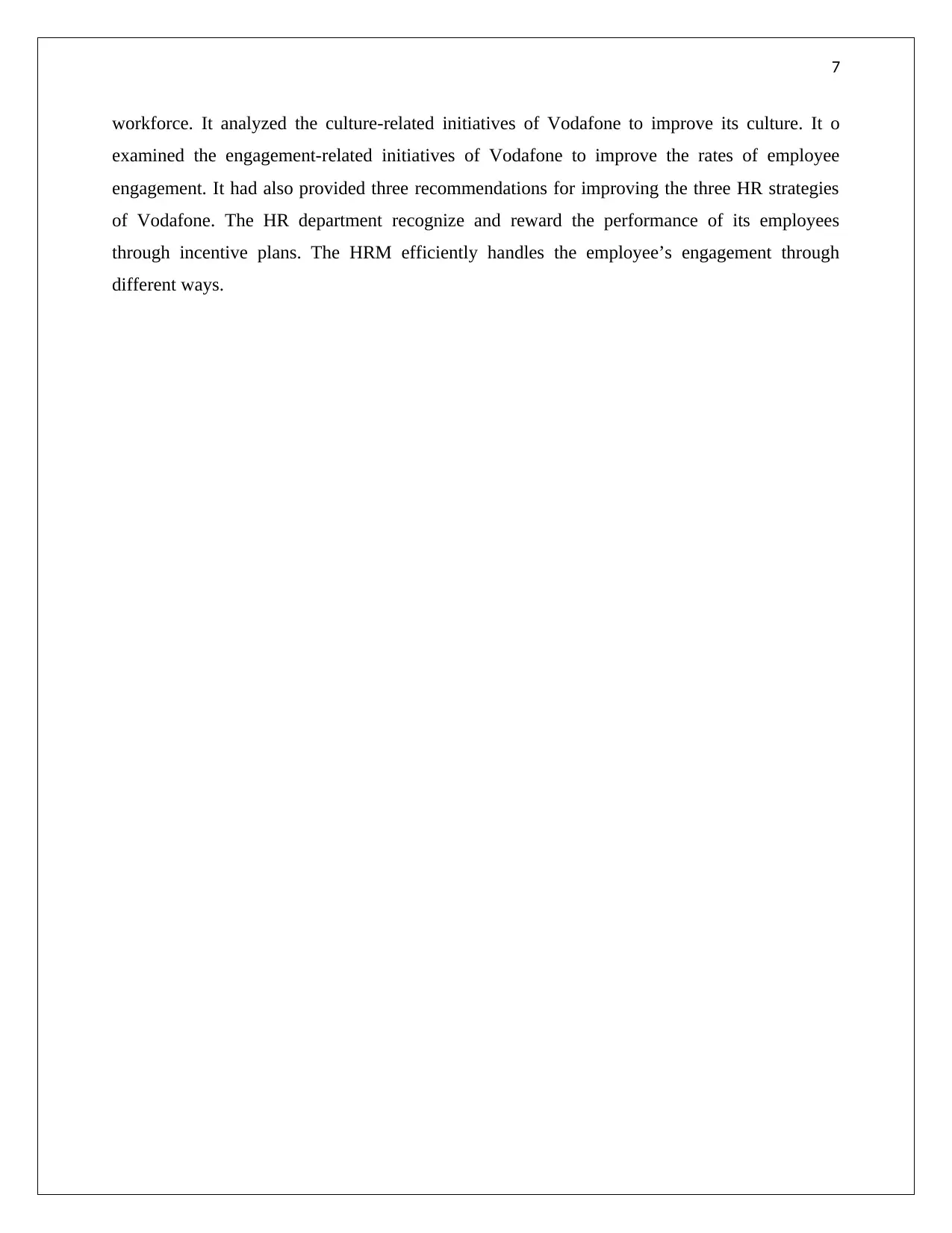
7
workforce. It analyzed the culture-related initiatives of Vodafone to improve its culture. It o
examined the engagement-related initiatives of Vodafone to improve the rates of employee
engagement. It had also provided three recommendations for improving the three HR strategies
of Vodafone. The HR department recognize and reward the performance of its employees
through incentive plans. The HRM efficiently handles the employee’s engagement through
different ways.
workforce. It analyzed the culture-related initiatives of Vodafone to improve its culture. It o
examined the engagement-related initiatives of Vodafone to improve the rates of employee
engagement. It had also provided three recommendations for improving the three HR strategies
of Vodafone. The HR department recognize and reward the performance of its employees
through incentive plans. The HRM efficiently handles the employee’s engagement through
different ways.
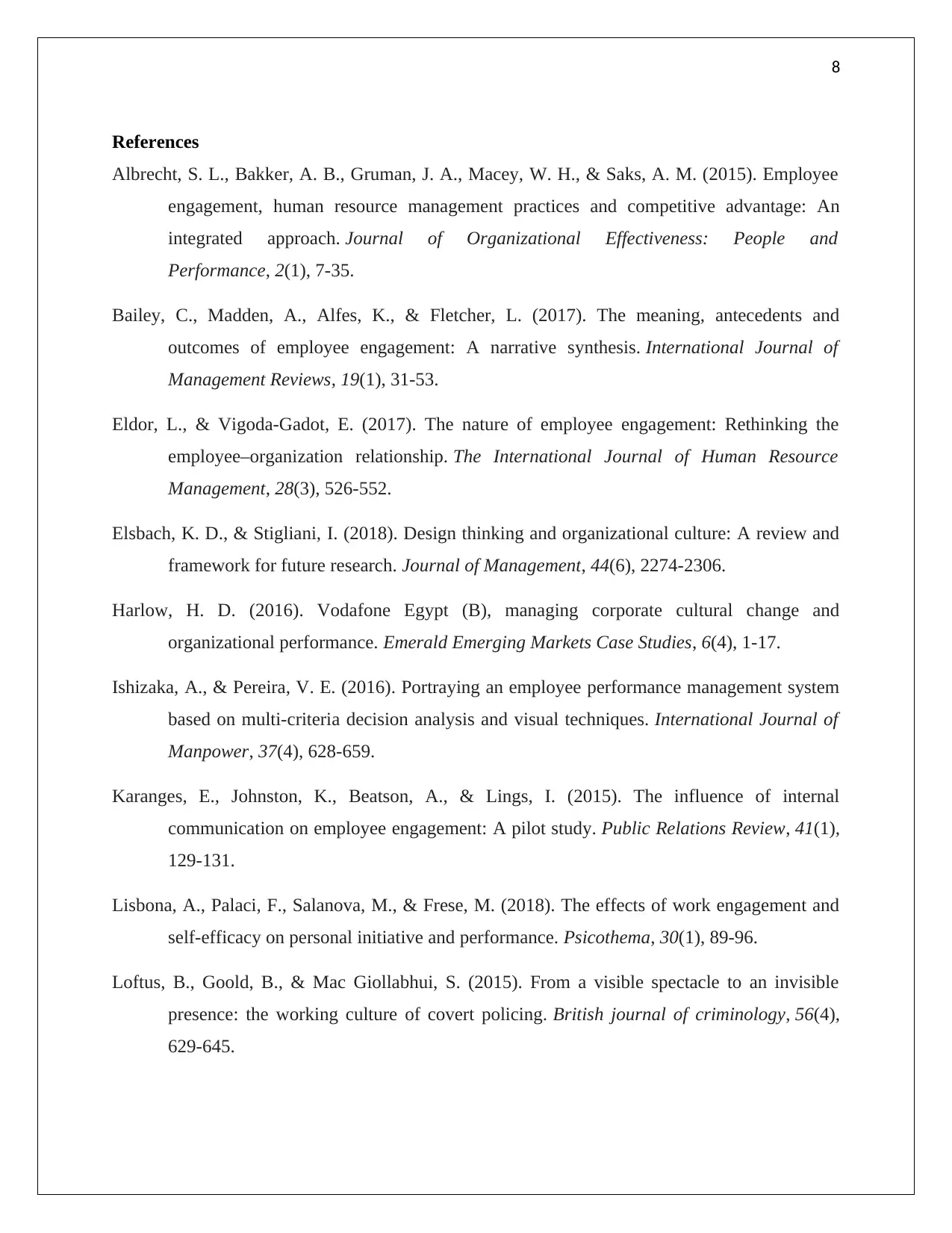
8
References
Albrecht, S. L., Bakker, A. B., Gruman, J. A., Macey, W. H., & Saks, A. M. (2015). Employee
engagement, human resource management practices and competitive advantage: An
integrated approach. Journal of Organizational Effectiveness: People and
Performance, 2(1), 7-35.
Bailey, C., Madden, A., Alfes, K., & Fletcher, L. (2017). The meaning, antecedents and
outcomes of employee engagement: A narrative synthesis. International Journal of
Management Reviews, 19(1), 31-53.
Eldor, L., & Vigoda-Gadot, E. (2017). The nature of employee engagement: Rethinking the
employee–organization relationship. The International Journal of Human Resource
Management, 28(3), 526-552.
Elsbach, K. D., & Stigliani, I. (2018). Design thinking and organizational culture: A review and
framework for future research. Journal of Management, 44(6), 2274-2306.
Harlow, H. D. (2016). Vodafone Egypt (B), managing corporate cultural change and
organizational performance. Emerald Emerging Markets Case Studies, 6(4), 1-17.
Ishizaka, A., & Pereira, V. E. (2016). Portraying an employee performance management system
based on multi-criteria decision analysis and visual techniques. International Journal of
Manpower, 37(4), 628-659.
Karanges, E., Johnston, K., Beatson, A., & Lings, I. (2015). The influence of internal
communication on employee engagement: A pilot study. Public Relations Review, 41(1),
129-131.
Lisbona, A., Palaci, F., Salanova, M., & Frese, M. (2018). The effects of work engagement and
self-efficacy on personal initiative and performance. Psicothema, 30(1), 89-96.
Loftus, B., Goold, B., & Mac Giollabhui, S. (2015). From a visible spectacle to an invisible
presence: the working culture of covert policing. British journal of criminology, 56(4),
629-645.
References
Albrecht, S. L., Bakker, A. B., Gruman, J. A., Macey, W. H., & Saks, A. M. (2015). Employee
engagement, human resource management practices and competitive advantage: An
integrated approach. Journal of Organizational Effectiveness: People and
Performance, 2(1), 7-35.
Bailey, C., Madden, A., Alfes, K., & Fletcher, L. (2017). The meaning, antecedents and
outcomes of employee engagement: A narrative synthesis. International Journal of
Management Reviews, 19(1), 31-53.
Eldor, L., & Vigoda-Gadot, E. (2017). The nature of employee engagement: Rethinking the
employee–organization relationship. The International Journal of Human Resource
Management, 28(3), 526-552.
Elsbach, K. D., & Stigliani, I. (2018). Design thinking and organizational culture: A review and
framework for future research. Journal of Management, 44(6), 2274-2306.
Harlow, H. D. (2016). Vodafone Egypt (B), managing corporate cultural change and
organizational performance. Emerald Emerging Markets Case Studies, 6(4), 1-17.
Ishizaka, A., & Pereira, V. E. (2016). Portraying an employee performance management system
based on multi-criteria decision analysis and visual techniques. International Journal of
Manpower, 37(4), 628-659.
Karanges, E., Johnston, K., Beatson, A., & Lings, I. (2015). The influence of internal
communication on employee engagement: A pilot study. Public Relations Review, 41(1),
129-131.
Lisbona, A., Palaci, F., Salanova, M., & Frese, M. (2018). The effects of work engagement and
self-efficacy on personal initiative and performance. Psicothema, 30(1), 89-96.
Loftus, B., Goold, B., & Mac Giollabhui, S. (2015). From a visible spectacle to an invisible
presence: the working culture of covert policing. British journal of criminology, 56(4),
629-645.
⊘ This is a preview!⊘
Do you want full access?
Subscribe today to unlock all pages.

Trusted by 1+ million students worldwide
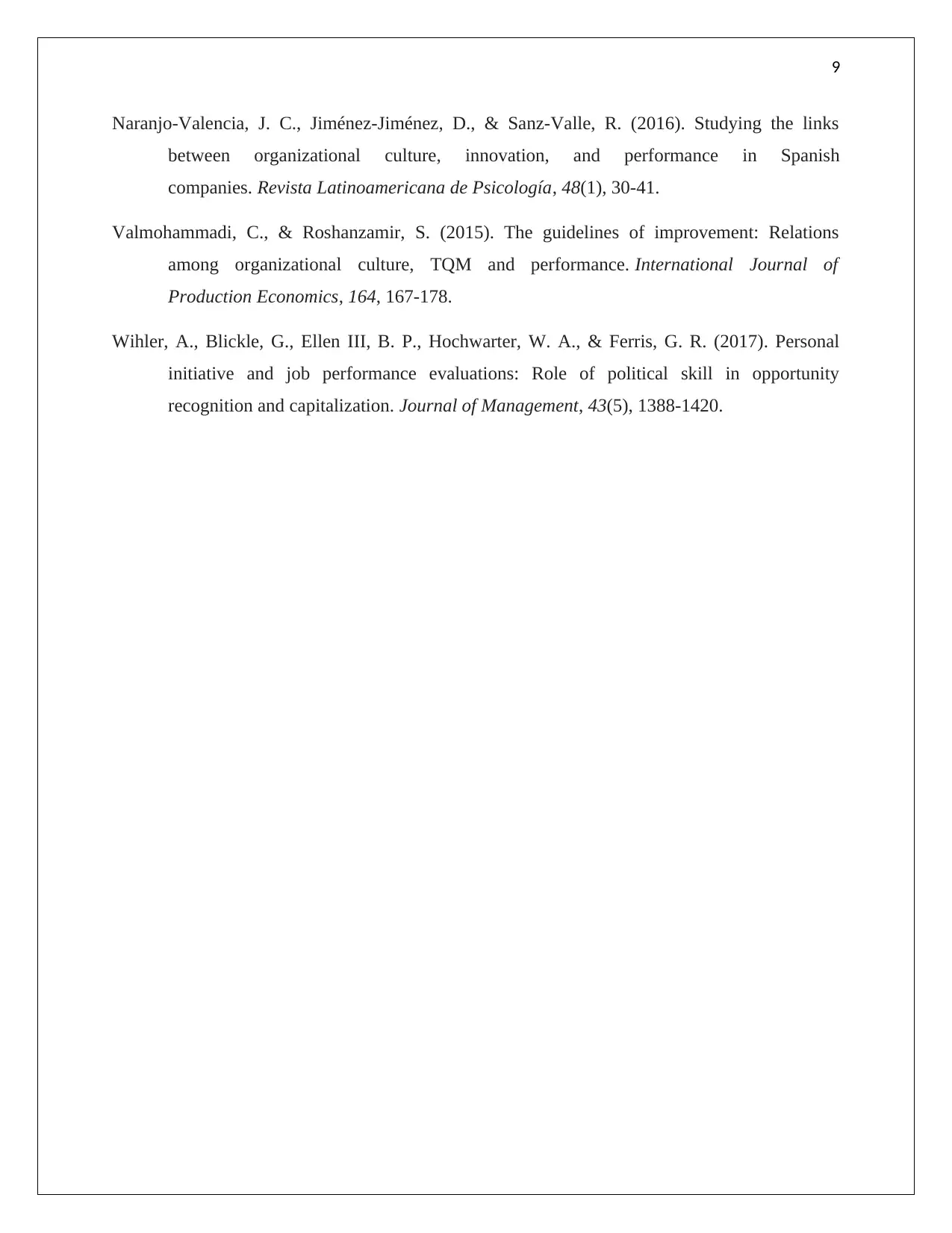
9
Naranjo-Valencia, J. C., Jiménez-Jiménez, D., & Sanz-Valle, R. (2016). Studying the links
between organizational culture, innovation, and performance in Spanish
companies. Revista Latinoamericana de Psicología, 48(1), 30-41.
Valmohammadi, C., & Roshanzamir, S. (2015). The guidelines of improvement: Relations
among organizational culture, TQM and performance. International Journal of
Production Economics, 164, 167-178.
Wihler, A., Blickle, G., Ellen III, B. P., Hochwarter, W. A., & Ferris, G. R. (2017). Personal
initiative and job performance evaluations: Role of political skill in opportunity
recognition and capitalization. Journal of Management, 43(5), 1388-1420.
Naranjo-Valencia, J. C., Jiménez-Jiménez, D., & Sanz-Valle, R. (2016). Studying the links
between organizational culture, innovation, and performance in Spanish
companies. Revista Latinoamericana de Psicología, 48(1), 30-41.
Valmohammadi, C., & Roshanzamir, S. (2015). The guidelines of improvement: Relations
among organizational culture, TQM and performance. International Journal of
Production Economics, 164, 167-178.
Wihler, A., Blickle, G., Ellen III, B. P., Hochwarter, W. A., & Ferris, G. R. (2017). Personal
initiative and job performance evaluations: Role of political skill in opportunity
recognition and capitalization. Journal of Management, 43(5), 1388-1420.
1 out of 10
Related Documents
Your All-in-One AI-Powered Toolkit for Academic Success.
+13062052269
info@desklib.com
Available 24*7 on WhatsApp / Email
![[object Object]](/_next/static/media/star-bottom.7253800d.svg)
Unlock your academic potential
Copyright © 2020–2025 A2Z Services. All Rights Reserved. Developed and managed by ZUCOL.





